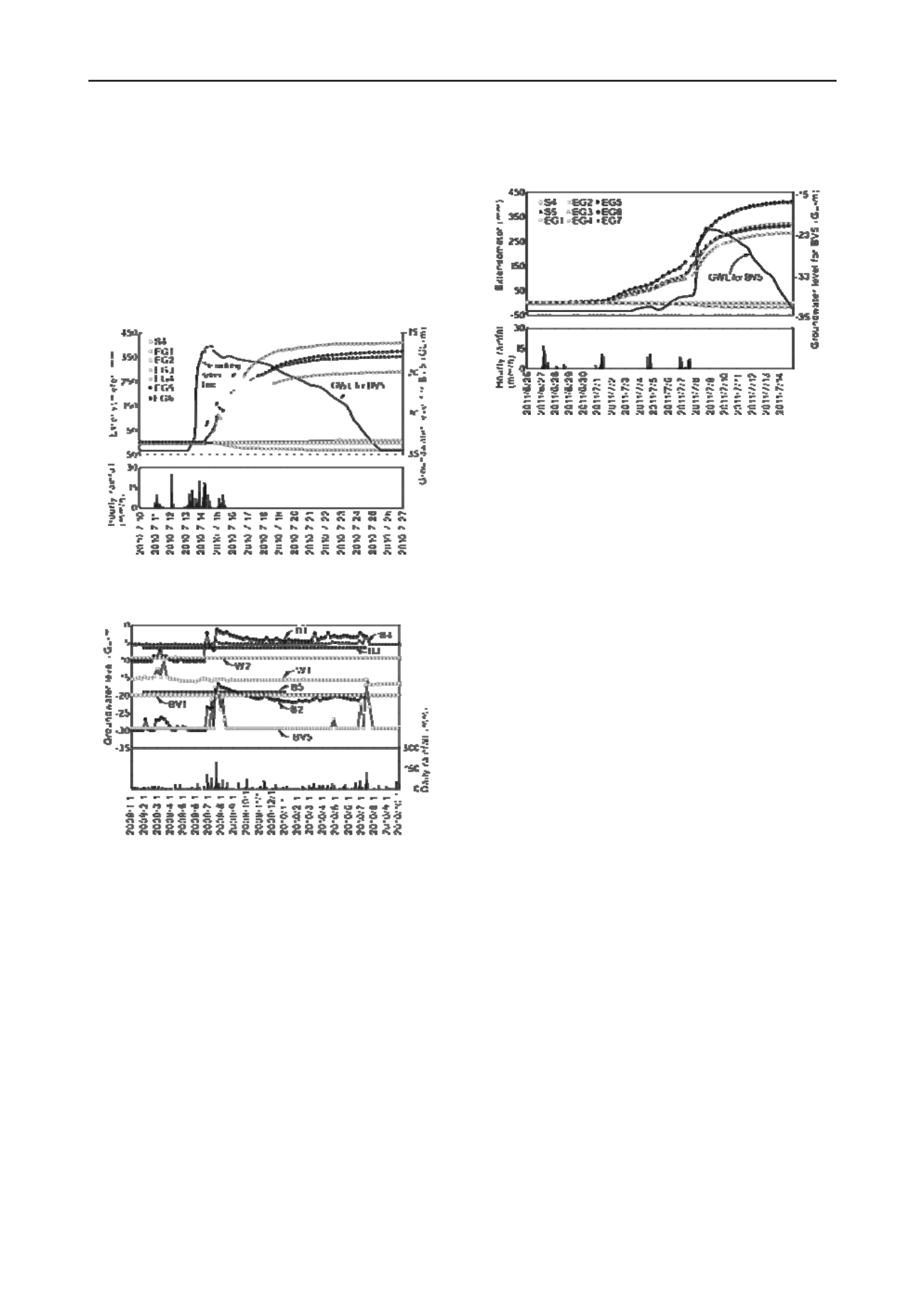
2228
Proceedings of the 18
th
International Conference on Soil Mechanics and Geotechnical Engineering, Paris 2013
From 7/14 to 7/15 the rate of deformation was 5 mm/hr to 15
mm/hr and on 7/16 to 7/18 it reduced to 1 to 5 mm/hr. From
7/18 it gradually decreased. From 7/19 it reduced to 1mm/hr
ceasing on the 7/22. The S-4 extensometer was set up on 7/17
because of the failure of C-2-1 and the enhanced risk of failure
of the RHS of the slope. During the time the ground water level
was going up, progression of displacement was not seen at all.
Moreover, displacement between -17m and -20 m of the
groundwater level was very remarkable. Furthermore, if the
groundwater level falls lower than -23m, it can be considered
that the movement of the block stopped in general.
Figure 8 Data of extensometers observed in July 2010
6.1 Rainfall record in 2009
Figure 9 Rainfall record between 2009 – 2010
In 2009, a significant rainfall had been experienced at the same
site as shown in Figure 9 with a maximum intensity of 62
mm/hr and cumulative intensity of 289mm over 3 days.
However there was no evident of deformation at that time. The
evidence indicates that it is difficult to predict the collapse
solely by the rainfall forecast. The GWL in B1 in 2009 was 10m
BGL compared to 3m BGL in 2010. The potential for slope
failure in 2010 was therefore higher. The general tendency over
the period 2009 to 2010 was for the GWL to be above normal.
6.2 Collapse behavior in 2011
Deformation of the slope was observed in 2011 due to the
smaller rainfall shown in Figure 10. The rainfall in 2011 started
on 6/27 and continued intermittently to 7/17. For 21 days, 4
major daily rainfall events were recorded; 60mm on 6/27,
40mm on 7/1, 30mm on 7/4 and 50mm on 7/8. The
extensometer begun to act on 7/1 before the GWL for BV5
elevated on 7/3. From this date, the deformation increased
gradually and accelerated on 7/7, rising with the rapid increase
in the GWL. During the ground water level rise and descent, the
displacement of the C-3 block was recorded. The maximum
displacement rate appeared during the water level rise while in
2010 it was during water level descent. This implies that the
timing of the warning official announcement would be earlier
more for the next heavy rainfall.
Figure 10 Data of extensometers observed at July in 2011
7 CONCLUSIONS
The paper focused on the evidence of collapse behavior for a
slope due to heavy rain in 2010. In the past the site had
experienced several collapses. An experimental research was
performed to understand the deformation behavior of sand
subjected to cyclic loading of pore water pressure using plane
strain compression apparatus. Then the observed data on the
collapsed slope in 2009-2011 was explained. Finally the lessons
from the data were discussed.
1) The experimental test results showed that cyclic loading of
pore water pressure never lead to any larger deformation
and failure except the first loading. The rigid-perfectly
plastic type behavior was observed for the sand specimen
subjected to the cyclic changes in pore water pressure.
2) In 2009, a significant rainfall fell at the same site. However,
there was no evidence of deformation at that time. This
indicated that it was difficult to predict the collapse by the
rainfall forecast only and a monitoring system is needed to
predict any deformation.
3) The collapse behavior started at the surface layer of the toe
part of the slope and then the movement of the major slip
block correlated with the rise of ground water level behind
the block. Therefore it is important to monitor the ground
water level at the appropriate points to understand the
collapse behavior.
8 ACKNOWLEDGEMENTS
The author gratefully acknowledges Mr. S. Yamada (Chugoku
Regional Development Bureau, MLIT) for providing the
monitoring data. This work was supported by Japan Society for
the Promotion of Science KAKENHI, Grant-in-Aid for
Scientific Research (B) 22360187.
9 REFERENCES
Ohtsuka S. and Miyata Y. 2001. Failure mechanism of clay in pore
water pressure loading test. Landslide 37(4), 10-17 (in Japanese).
Orense R., Farooq K. and Towhata I. 2004. Deformation behavior of
sandy slopes during rainwater infiltration. Soils and Foundations
44( 2), 15-30.


